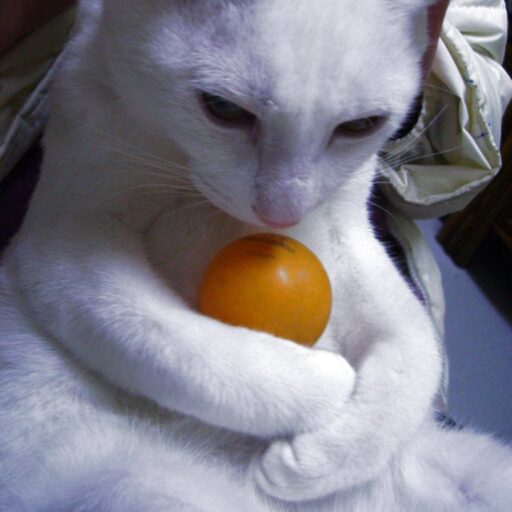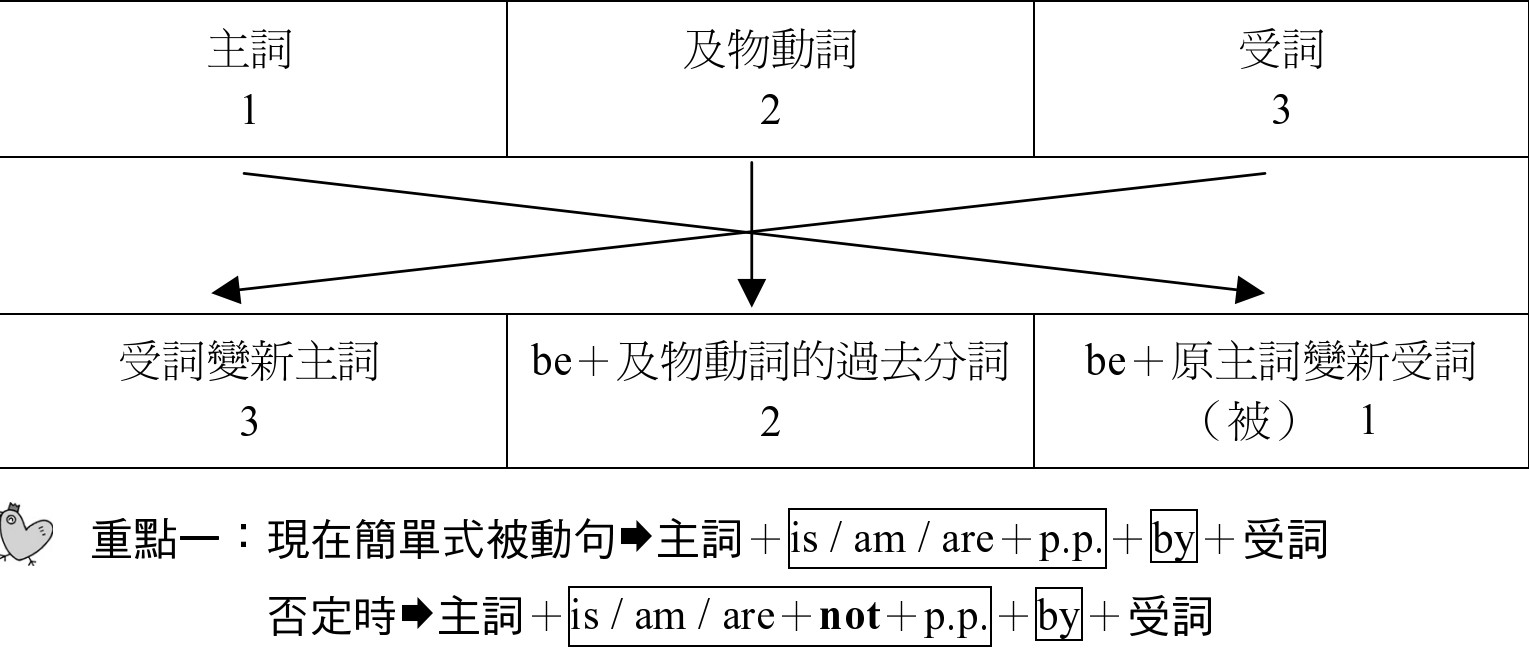被動語態文法句型
主詞(動作的承受者)+be動詞+過去分詞pp+(by +動作的施予者)不能做出該動作的主詞就要使用被動,如食物被吃、衣服被穿、照片被拍…..
被動的基本結構是 be動詞+PP
(be動詞是助動詞, 主要動詞的詞彙意義在「過去分詞pp」。)
被動語態的BE動詞決定時態
不一定都有「by ….」片語。動作的產生者為people、you、we、they、someone等不特定對象時,「by ….」片語可省略。
被動語態時態表
| 時態 | 變化 | 例句 |
| 現在簡單式的被動 | is / am / are+p.p. | The cake is eaten by me. 蛋糕被我吃 |
| 過去簡單式的被動 | was / were+p.p. | The cake was eaten by me. |
| 未來簡單式的被動 | will be+p.p. | The cake will be eaten by me. |
| 現在進行式的被動 | is / am / are+being+p.p. | The cake is being eaten by me. |
| 過去進行式的被動 | was / were+being+p.p. | The cake was being eaten by me. |
| 現在完成式的被動 | have / has been p.p. | The cake has been eaten by me. |
| 過去完成式的被動 | had / been p.p. | The cake had been eaten by me. |
沒有被動語態的動詞
連綴動詞(如look、taste、happen、cost、have(有)、look、feel、smell、become)沒有被動形式。cost(花費)、take(花費)、have(有)等動詞也沒有被動式。
被動片語動詞
My father was surprised at the news.
→ The news surprised my father.
My brother is bored with math.
→ Math bores my brother.
A lot of people are excited about Harry Potter.
→ Harry Potter excites a lot of people.
be known to (被~所知)
be filled with =be full of (被充滿)
be covered with (被覆蓋)
be made of (材料可見)
be made from (型態改變)以~製成
否定句被動
在「be動詞」後面加not。
The cake was not made by Mom. 蛋糕不是被媽媽製作的。
The wound must not be moved at random.
被動語態疑問句
1. be動詞為首的問句→依一般Yes-No句型變化之。
直述句:Most of the websites are built in English.
疑問句:Are most of the websites built in English?
回答:Yes, they are.
2. 疑問詞為首的問句→依一般疑問詞句型變化之【疑問詞+be動詞+主詞…..】。
疑問句:When was the book put on the desk by John? 答:Yesterday.
Where was the book put by John yesterday? 答:On the desk.
What was put on the desk by John yesterday? 答:The book.
By whom was the book put on the desk yesterday? 答:John.
說明:詢問被動動作的產生者(John)時,須以「介係詞+whom/ what」為首來發問。
The book was written by a famous artist.=By whom was the book written?
The bugs have been killed by the modern machine.=By what have the bugs been killed?
使役動詞被動語態
主動句型:主詞+使役動詞+受詞+原形動詞.
被動句型:主詞+be動詞+使役動詞過去分詞+to+原形動詞+by+受詞.
A be made/had to VR by sb. (A被要求做某事)
主動:My mother made me do the housework yesterday. (我媽媽昨天命令我做家事。)
被動:I was made to do the housework yesterday by my mother .(我昨天被媽媽命令做家事)
主動語態使役動詞句中的受詞,原本使用 「原型動詞」,為特殊動詞用法。但改成被動語態後,因主要動詞為be動詞,p.p.(使役動詞)失去原本的使役特性,需視為一般動詞的過去分詞。故不可以在句中出現第二個動詞。故主動語態的「原形動詞」需改為「不定詞」,並置於被動句中的過去分詞之後。
主動:Cindy has us hand in the report right away. (Cindy要求我們立刻繳交報告。)
被動:We are had to hand in the report right away by Cindy. (我們被Cindy要求立刻繳交報告)
主動:Mom made Susan wash the dishes this evening. 媽媽今天晚上命令蘇珊洗碗
被動:Susan was made to wash the dishes this evening.
let在被動語態中,不被使用。要改成此字allow(允許)。
主動句型:主詞+let+受詞+原形動詞.
被動句型:主詞+be動詞+allowed+to+原形動詞+by+受詞.
主動: My father let me go shopping with my friends.
被動:I was allowed to go shopping with my friends by my father.
Our teacher lets us eat in class.(我們老師讓我們上課吃東西)
→ We are allowed to eat in class by our teacher.
感官動詞被動語態
感官動詞後加原形動詞 (強調事實)
主動:I heard(過去式) the bird sing in the tree. (和使役動詞用法相同)
被動:The bird was heard(p.p.) to sing in the tree (by me).
主動: A +感官動詞 look at/watch/see/listen to/herar/feel +原型動詞(VR).
A+ be+ looked at/seen/watched/listened to/heard/felt/noticed +to rv+by+受詞. (A被看到做某事)
主動:Jack heard the bird sing this morning.(今天早上傑克聽到小鳥唱歌。)
被動: The bird was heard to sing this morning by Jack.
感官動詞後加Ving (強調看/聽/注意到某事進行的過程)
主動:I heard the bird singing in the tree.
被動:The bird was heard(p.p.) singing in the tree (by me).
主動: A +感官動詞 look at/watch/see/listen to/hear/feel +現在分詞(Ving)
A+ be+ looked at/seen/watched/listened to/heard/felt/noticed + 現在分詞(Ving) +by+受詞.(A被看到做某事)
主動:Ivy saw the old lady crossing the road. Ivy看那位老婦人過馬路。
被動:The old lady was seen crossing the road by Ivy.
說明:感官動詞(see、hear、feel)在主動句中受詞補語是「原形動詞」,而在被動句中,原來的受詞補語要改成「to-V」形式。主動態為ving則維持不變,置於被動be+pp之後。
授與動詞被動語態
主動:A +give +B+ 物.
被動:B +be+p.p.+ 物 +by A.
主動:Tom gave Mary a comic book.
被動:Mary was given a comic book by Tom.
說明:主動句中的間接受詞(Mary)當被動式中的主詞時,不需介係詞。
主動: A give 物 to 人.
被動:物+be +p.p. +to /for B +by+ A
主動:Tom gave a book to Mary.
被動:A comic book was given to Mary by Tom.
說明:主動句中的直接受詞(a comic book)當被動式中的主詞時,需介係詞。
主動:Nancy bought Jack pearl milk tea. Nancy bought pearl milk tea for Jack.
被動:Pearl milk tea was bought for Jack by Nancy.
主動句中的直接受詞(pearl milk tea)當被動式中的主詞時,需介係詞。
【誤】Jack was bought pearl milk tea by Nancy 語意上,Jack不會被買。
含助動詞的被動語態
說明:may have pp指對過去可能的推測。
The machine should have been used by engineers only.
說明:should have pp指過去原本該做而沒做。
例如:Students have to do the homework by themselves.
The homework has to be done by students themselves.
1. 由於助動詞的關係,be動詞要用原形,而be動詞之後的結構不變。
2. 含助動詞的被動語態的否定句是將助動詞改為否定形式,而不是在be後面加not。
need的主詞為物時,以現在分詞表被動。
Need ving表被動
need的主詞為物時,以現在分詞表被動
例如:The dishes need washing.=The dishes need to be washed.
例如:The dishes need washing.→The dishes need to be washed.
表示客觀的說明,且說話者無特定對象時可用
It is +p.p. that 名詞子句句型(等於 People ……)
It is believed by many people that it is bad luck to enter the tomb.
→People believe that it is bad luck to enter the tomb.
其他常見片語有:It is said that….(據說)、It is reported…(據報導)、It is thought….(大家認為)
- 感官動詞文法 look at watch see
- 感官動詞與連綴動詞傻傻搞不懂!!
- 連綴動詞文法 linking Verbs
- 連綴動詞 Linking Verb become/turn/get/go/grow
- 連綴動詞 seem appear keep stay remain
- 英文越來越比較級 the more the more
- 被動語態(感官&使役&授與動詞)
- 沒有被動語態的動詞
- find, keep, leave, catch 文法
- 授與動詞(雙賓動詞)記憶口訣
- To VR 不定詞&V-ing 動名詞文法
- 不定詞的否定not+to+V
- Go ving 從事某種活動文法
- 不定詞做形容詞及副詞的文法
- in order to 為了…目的
- 哪些動詞後接不定詞(to VR)
- 哪些動詞片語後接Ving(動名詞)
- 動詞後to為介係詞 to ving/N
- spend cost take pay 文法
- 英文祈使句文法 Imperative Sentence
- 使役動詞 make/have/let 受詞 VR
- 命令、要求、讓某人做某事 make sb. VR
- 瞬間動詞有哪些 Momentary Verbs
- 情態副詞文法
- waste 浪費時間金錢英文怎麼說

